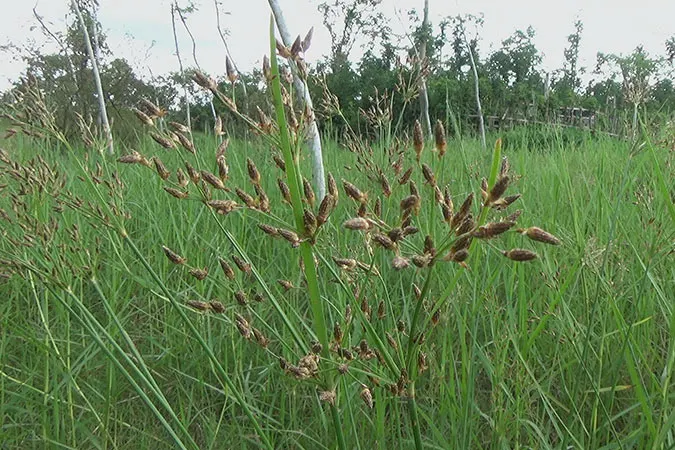Gal fimbry (Fimbristylis dura) is a species of plant in Cyperaceae, herbaceous, erect, short rhizome, cylindrical stem, solitary or tufted, 45-75 cm long, 2-4 mm wide, dense, striated, segmented, green. and grows where there is plenty of sun in the forest.
F. dura has ribbon-shaped leaves, green, hairy, shorter than or along the stem. Leaf blade linear, 3-8 mm wide, scaly apical edge and pointed tip. The top leaves are longer than the inflorescences.
Inflorescence compound in panicles at the top end of the stem, erect, stalked and branched. Spikelet solitary, oval to ovoid with a pointed tip, 4-10 mm long, 1-1.5 mm wide and brown.
Gal fimbry grows alongside other shrubs in forests, plantations, savannas and deserts, riverbanks, damp places with shade to plenty of sun.
Kingdom: Plantae
Phylum: Tracheophyta
Subphylum: Angiospermae
Class: Liliopsida
Order: Poales
Family: Cyperaceae
Subfamily: Cyperoideae
Tribe: Abildgaardieae
Genus: Fimbristylis
Species: Fimbristylis dura
F. dura has ribbon-shaped leaves, green, hairy, shorter than or along the stem. Leaf blade linear, 3-8 mm wide, scaly apical edge and pointed tip. The top leaves are longer than the inflorescences.
Inflorescence compound in panicles at the top end of the stem, erect, stalked and branched. Spikelet solitary, oval to ovoid with a pointed tip, 4-10 mm long, 1-1.5 mm wide and brown.
Gal fimbry grows alongside other shrubs in forests, plantations, savannas and deserts, riverbanks, damp places with shade to plenty of sun.
Kingdom: Plantae
Phylum: Tracheophyta
Subphylum: Angiospermae
Class: Liliopsida
Order: Poales
Family: Cyperaceae
Subfamily: Cyperoideae
Tribe: Abildgaardieae
Genus: Fimbristylis
Species: Fimbristylis dura
